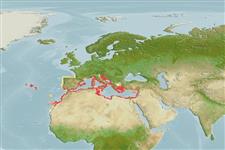Elasmobranchii (Haie und Rochen) (sharks and rays) >
Carcharhiniformes (Ground sharks) >
Triakidae (Houndsharks) > Triakinae
Etymology: Mustelus: Latin for weasel, an ancient name for sharks, possibly referring to the pointed snouts, swift movements and/or rapacious feeding behavior of smaller predatory sharks [strictly not tautonymous with Squalus mustelus Linnaeus 1758 since type was designated by the ICZN]. (See ETYFish); punctulatus: Diminutive of punctum (L.), spot, i.e., having tiny spots, referring to small black spots often present on body. (See ETYFish).
More on author: Risso.
Environment: milieu / climate zone / depth range / distribution range
Ökologie
seewasser demersal. Subtropical; 45°N - 20°N
Eastern Atlantic: Mediterranean to Western Sahara. Confused with Mustelus mustelus and most data for this species were in part attributable to Mustelus mediterraneus.
Length at first maturity / Size / Gewicht / Alter
Maturity: Lm 95.0, range 60 - 100 cm
Max length : 190 cm TL Männchen/unbestimmt; (Ref. ); common length : 120 cm TL Männchen/unbestimmt; (Ref. )
An inshore, continental bottom-dwelling shark. Probably a crustacean feeder. Presumably viviparous.
Probably viviparous (Ref. 244). Distinct pairing with embrace (Ref. 205).
Compagno, L.J.V., 1984. FAO Species Catalogue. Vol. 4. Sharks of the world. An annotated and illustrated catalogue of shark species known to date. Part 2 - Carcharhiniformes. FAO Fish. Synop. 125(4/2):251-655. Rome: FAO. (Ref. 244)
IUCN Rote Liste Status (Ref. 130435)
Bedrohung für Menschen
Harmless
Nutzung durch Menschen
Fischereien: kommerziell
Mehr Information
Alter/GrößeWachstumLänge-GewichtLänge-LängeLängenhäufigkeitenMorphometrieMorphologieLarvenLarven Pop.Dyn.RekrutierungDichteBRUVS
ReferenzenAquakulturAquakultur ProfilZuchtlinienGenetikElectrophoresesVererbbarkeitKrankheitenVerarbeitungNutrientsMass conversion
PartnerBilderStamps, Coins Misc.LauteCiguateraGeschwindigkeitSchwimmstilKiemenoberflächeOtolithsGehirngrößeSehfähigkeit
Tools
Zusatzinformationen
Download XML
Internet Quellen
Estimates based on models
Preferred temperature (Ref.
123201): 15.3 - 21.6, mean 18.8 °C (based on 182 cells).
Phylogenetic diversity index (Ref.
82804): PD
50 = 0.5000 [Uniqueness, from 0.5 = low to 2.0 = high].
Bayesian length-weight: a=0.00347 (0.00219 - 0.00549), b=3.16 (3.03 - 3.29), in cm total length, based on LWR estimates for this species & Genus-body shape (Ref.
93245).
Trophic level (Ref.
69278): 3.8 ±0.4 se; based on diet studies.
Generation time: 3.3 ( na - na) years. Estimated as median ln(3)/K based on 1
growth studies.
Widerstandsfähigkeit (Ref.
120179): niedrig, Verdopplung der Population dauert 4,5 - 14 Jahre. (tm=1.3-2.6(?); Fecundity is presumably low like other Mustelus species).
Fishing Vulnerability (Ref.
59153): Moderate to high vulnerability (51 of 100).
Nutrients (Ref.
124155): Calcium = 15.9 [4.3, 80.9] mg/100g; Iron = 0.485 [0.153, 1.866] mg/100g; Protein = 22.1 [19.7, 24.4] %; Omega3 = 0.144 [0.057, 0.357] g/100g; Selenium = 54.4 [14.4, 196.5] μg/100g; VitaminA = 3.8 [1.2, 12.1] μg/100g; Zinc = 0.461 [0.202, 0.945] mg/100g (wet weight);
